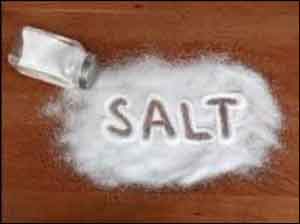- Home
- Editorial
- News
- Practice Guidelines
- Anesthesiology Guidelines
- Cancer Guidelines
- Cardiac Sciences Guidelines
- Critical Care Guidelines
- Dentistry Guidelines
- Dermatology Guidelines
- Diabetes and Endo Guidelines
- Diagnostics Guidelines
- ENT Guidelines
- Featured Practice Guidelines
- Gastroenterology Guidelines
- Geriatrics Guidelines
- Medicine Guidelines
- Nephrology Guidelines
- Neurosciences Guidelines
- Obs and Gynae Guidelines
- Ophthalmology Guidelines
- Orthopaedics Guidelines
- Paediatrics Guidelines
- Psychiatry Guidelines
- Pulmonology Guidelines
- Radiology Guidelines
- Surgery Guidelines
- Urology Guidelines
Community-based salt substitution improves BP and hypertension control: ESC 2019 Update

A community-based salt substitution programme in Peru lowered blood pressure and cut new cases of hypertension. Swapping in some potassium by providing all families, shops, bakeries, and restaurants free salt with potassium chloride had this important effect. The late-breaking research was presented in a Hot Line Session today at ESC Congress 2019 together with the World Congress of Cardiology.
Senior author Dr Jaime Miranda from the CRONICAS Centre of Excellence in Chronic Diseases at Universidad Peruana Cayetano Heredia (Cayetano Heredia Peruvian University), Lima, Peru said: “Across the world, many societies consume more than the recommended amount of salt. Our sodium reduction intervention lowered blood pressure across communities, with particular benefits in people with hypertension, and reduced the occurrence of new hypertension.”
The study used a salt substitute containing 75% sodium and 25% potassium. It was made by mixing equal parts of normal salt (100% sodium) and a commercially available low-sodium product (50% sodium, 50% potassium). Prior research by the group found that the sodium content of salt could be reduced by up to 35% without a noticeable difference in taste.
A stepped wedge cluster randomised trial was conducted between 2014 and 2017 in six villages in Tumbes, a region with high levels of sodium consumption and hypertension. Blood pressure was measured at the beginning of the study and every five months, for a total of seven measurements. Every five months, a village was randomly selected to join the intervention, so that in the final period of the study all villages were in the intervention group.
Prior research showed that Tumbes residents did not make a connection between sodium intake and blood pressure and found dietary change difficult. The study, therefore, used an innovative social marketing campaign to introduce a new product called Salt-Liz, a name chosen and approved by locals. Salt-Liz was provided to households, grocery shops, community kitchens, and street vendors.
When it was a village’s turn to join the intervention, households, shops, and vendors choosing to participate were given Salt-Liz in exchange for their own salt. When they ran out, they were given more.
A total of 2,376 individuals were involved in the study. Half were females and the average age was 43 years. In the overall population, the salt substitute reduced systolic blood pressure by an average of 1.23 mmHg and diastolic blood pressure by an average of 0.72 mmHg. Blood pressure reductions were even greater in individuals with hypertension at baseline: average reductions in systolic and diastolic blood pressures were 1.74 mmHg and 1.25 mmHg, respectively.
Among the 1,865 participants (79%) without hypertension at baseline, the salt substitute significantly reduced the likelihood of developing hypertension by 51% compared to using normal salt (hazard ratio 0.49; 95% confidence interval 0.34–0.71; p<0.001).
Dr Miranda said: “This study was designed to generate small decreases in blood pressure at the population level; it was not a drug trial. This was achieved with the intervention, which also had two additional benefits. First, it lowered blood pressure even more in people with hypertension. Second, it stopped many people without hypertension from getting it. These gains can be sustained over time if people continue using the salt substitute.”
To test adherence to the intervention, urine samples were taken in a subset of 600 participants at baseline and three years. Potassium levels increased while sodium levels did not change.
“People may have replaced their sodium intake with other products, but the rise in potassium suggests they did use the salt substitute,” said Dr Miranda. “We also collected qualitative information showing that people liked using the product. Some women told us they switched to the new salt and their families hadn’t noticed.”
The study demonstrates that population-wide changes in sodium intake and blood pressure are feasible, noted Dr Miranda. “The intervention was simple, highly acceptable, and low cost. Rather than pushing a healthy behavior change, we engaged people by marketing a new product. Palates adapt, and it is possible that we could return to those villages and reduce sodium even more without a recognizable change in taste.”
Regarding roll out of the intervention to other settings and countries, Dr Miranda said the results provide the basis for different population strategies to reduce sodium consumption. He said: “The reality is that we, as individuals, do not regularly check our sodium or potassium intake, nor should we be doing so. Given the alarming rates of non-adherence to drug therapy of hypertension globally, we urgently require non-pharmacological measures at the population level to improve blood pressure control.”
“Hence, innovative approaches like this marketing campaign we used to introduce a salt substitute prove that changes can be introduced and sustained. The salt substitute can be used at the community level, as in our study. But it could also be adopted by food manufacturers and larger shops to nudge behavior change in a healthy direction,” he said.

Disclaimer: This site is primarily intended for healthcare professionals. Any content/information on this website does not replace the advice of medical and/or health professionals and should not be construed as medical/diagnostic advice/endorsement or prescription. Use of this site is subject to our terms of use, privacy policy, advertisement policy. © 2020 Minerva Medical Treatment Pvt Ltd